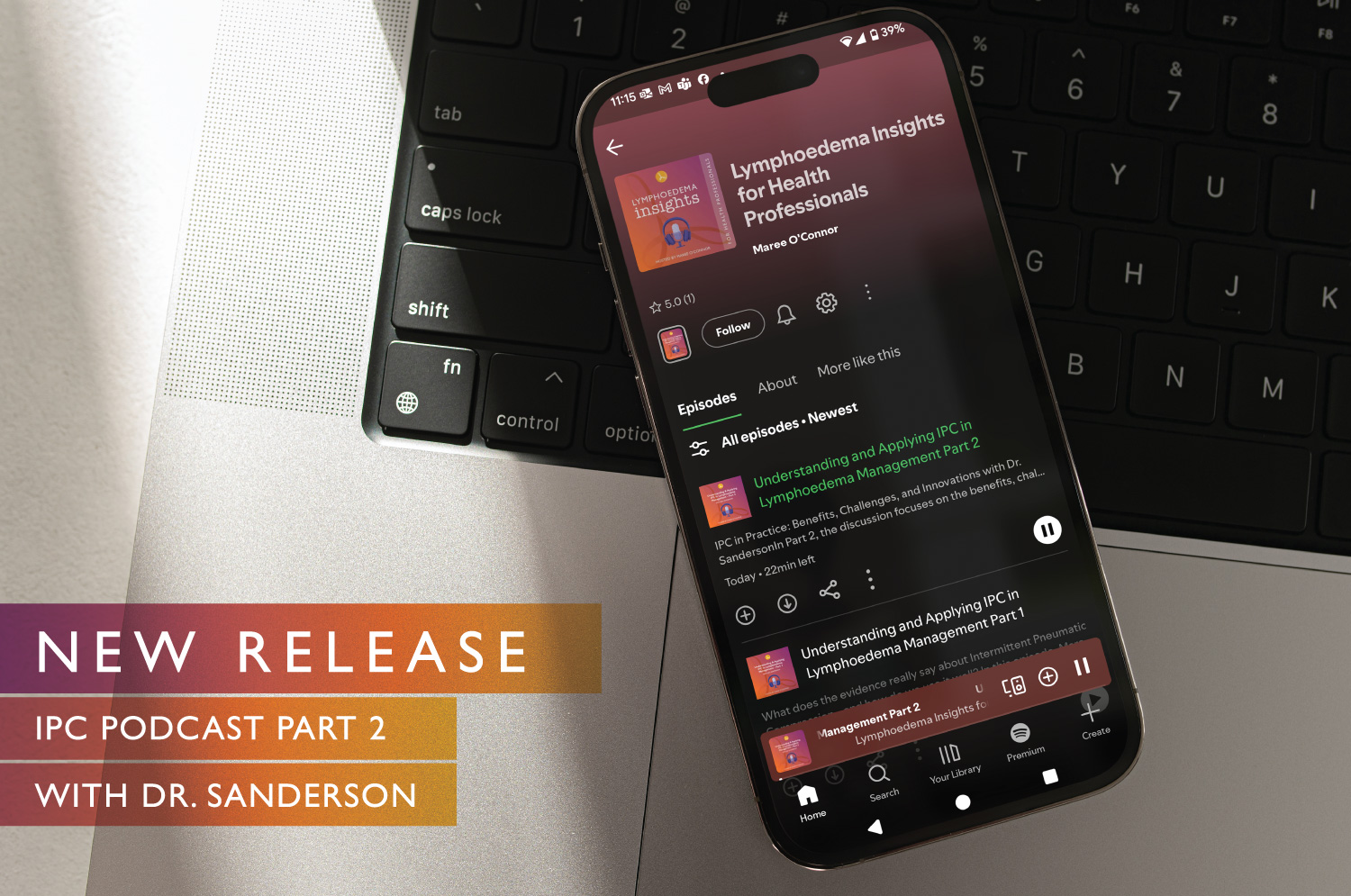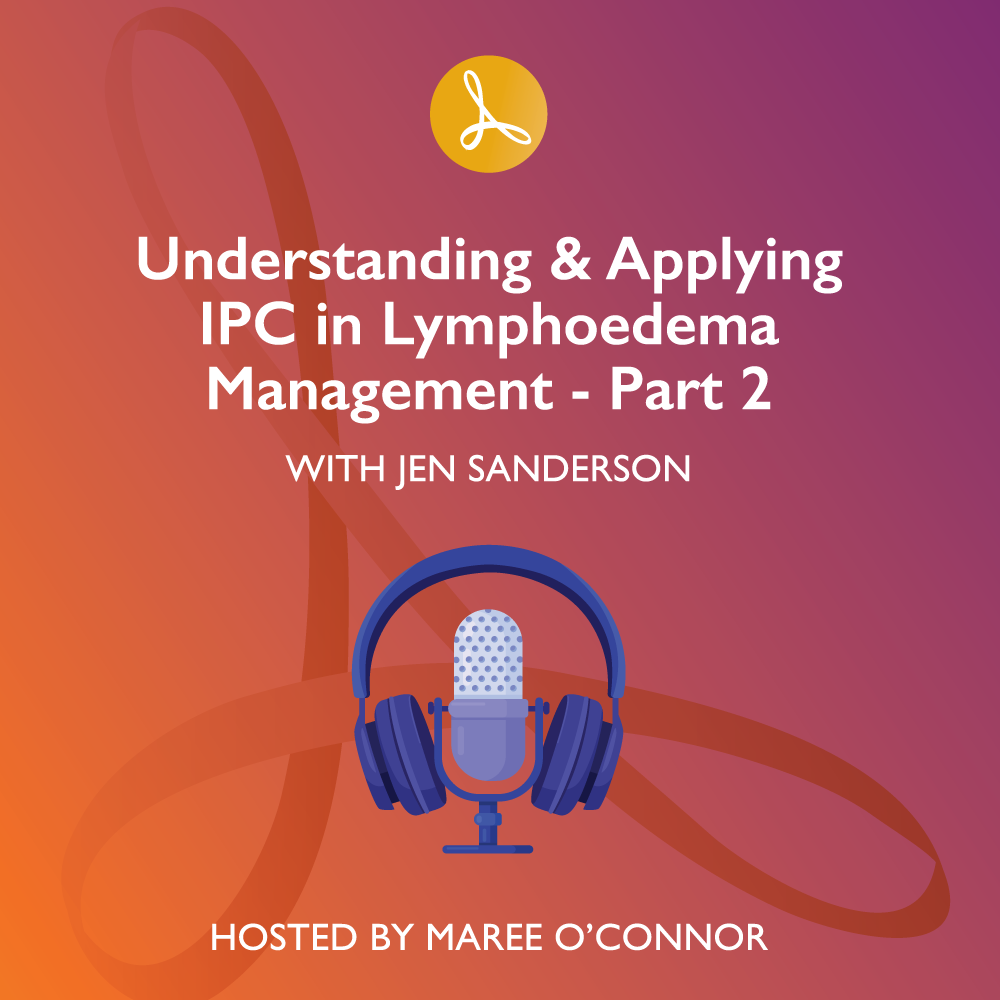Understanding and Applying IPC in Lymphoedema Management Part 2

We’re excited to share a new way LES will be supporting learning and clinical practice – through our podcast, Lymphoedema Insights for Health Professionals.
Hosted by Maree O’Connor, each episode explores current questions, emerging evidence, and practical strategies for clinicians working with people affected by lymphoedema and chronic oedema. Whether you’re new to the field or looking to deepen your understanding, the podcast offers thoughtful, clinically grounded insights to support confident, person-centred care.
IPC in Practice: Benefits, Challenges, and Innovations with Dr. Sanderson (Part 2)
In Part 2, the discussion focuses on the benefits, challenges, and future innovations of IPC. Dr. Sanderson highlights the psychological benefits of IPC, particularly its ability to empower patients with self-efficacy and control over their lymphedema management. She notes that IPC can support self-management, especially for clients with limited mobility, but stresses the need for proper assessment and medical supervision. Challenges include cost, access, and training, though resources like Medi-Rent’s learning hub and equipment loans can help clinicians integrate IPC into practice. Misconceptions about IPC, such as concerns about moving fluid to other areas, are addressed, with Dr. Sanderson explaining how improved technology and understanding of lymphatic pathways mitigate these risks. She also discusses innovations like hoseless devices and touch-screen interfaces, which are expected to improve IPC functionality. Finally, Dr. Sanderson advises clinicians to utilize available educational resources and try IPC themselves before prescribing it to patients.
About our guest speaker: Dr Jen Sanderson
Jen Sanderson is a Physiotherapist with special interests in lymphoedema, pain and chronic disease. Jen has completed a PhD focussed on assessment of lymphoedema tissue composition including the pitting test and is passionate about using assessment to guide effective treatment in chronic conditions. Jen is Medi-Rent’s Clinical Lead for their range of medical devices which includes a range of compression pump products.
🎧 Listen to Episode 2 – now available on Spotify and Apple Podcasts
Key takeaways from this episode include:
- Empowering Patients with Self-Efficacy: IPC provides patients with a tool to manage fluctuations in swelling independently, fostering a sense of control over their lymphedema and improving mental well-being.
- Support for Self-Management: IPC can be beneficial for clients with limited mobility or in home-based settings, but its suitability must be assessed on an individual basis. Patients should consult healthcare professionals to ensure IPC is safe and effective for their circumstances.
- Challenges in Implementation: Cost is a significant barrier for patients accessing IPC devices, though more affordable options are becoming available. Clinicians can utilize free resources like Medi-Rent’s learning hub and equipment loans to learn about IPC and integrate it into practice.
- Addressing Misconceptions: Concerns about IPC causing fluid movement to other areas are largely outdated due to advancements in technology and understanding of lymphatic pathways. Proper garment coverage and device settings can mitigate risks and tailor treatment to individual needs.
- Innovations in IPC Technology: Upcoming advancements include hoseless devices (with integrated pump and battery) and touch-screen interfaces for more tailored compression settings. Improved sleeve designs and air chamber configurations enhance pressure distribution and treatment efficacy.
- Reduced Need for Bandaging: IPC can be used effectively during the reduction phase of treatment, reducing reliance on traditional bandaging methods, especially in private practice settings.
- Integration with Other Therapies: IPC can complement exercise, skin care, and other lymphedema management strategies without replacing them. It is particularly useful for reducing swelling during the decongestive phase and maintaining limb size while waiting for compression garments.
- Considerations for Aged Care Settings: IPC may be helpful in aged care, but implementation requires trained staff to ensure medical safety, proper use, and follow-up. Education and integration of care workers and nurses are essential for successful use in residential facilities.
- Advice for Clinicians: Utilise educational resources like webinars, case studies, and research summaries to inform practice. Try IPC devices personally to understand their effects and make informed decisions for patients.
Subscribe now to stay updated as new episodes are released.
Catch up
🎧 Listen to Episode 1 – now available on Spotify and Apple Podcasts
Sponsorship:
This episode of Lymphoedema Insights is proudly supported by Medi-Rent, suppliers of high-quality intermittent pneumatic compression devices for lymphoedema care. With a commitment to clinical education and patient outcomes, Medi-Rent partners with healthcare providers across Australia to deliver evidence-based solutions that support lymphoedema management.
You can find more information at medirent.com.au
Note: Sponsorship does not imply endorsement, and all educational content is developed independently to ensure it remains evidence-based and unbiased.





